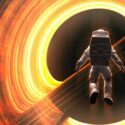Get ready for the most epic party of your life. Because someone replaced our Moon with a disco ball. How could you turn the Moon into a classic disco ball? How much more light could this new Moon reflect? And would it actually turn the Earth into one giant nightclub?
No matter how bright it seems, the Moon doesn’t produce any light of its own. Instead, it gets its shine by reflecting about 10% of the incoming sunlight that hits it. And thanks to the uneven surface of the Moon, that light is reflected at many different angles. If we made the Moon more like the disco ball, we could change the way it reflects light entirely.
Disco balls cast dazzling beams of light all over a room. They do that thanks to their many mirrored tiles. Now imagine a disco ball the size of our Moon in our night sky. Would it spark an amazing rave back on Earth? Or would it literally ignite fires? Well, where would you even start? Knocking the Moon out of its orbit and placing a giant disco ball in its place could be quite problematic.
You could start with something a little less dramatic. Like covering the Moon in mirror tiles. A disco ball has a radius of anywhere between 10 to 183 cm (4 to 72 in). The Moon, however, is bigger. Much bigger. It has a radius of about 1,700 km (1,080 mi). Making a disco ball that large would require covering the Moon’s surface with over 3,000 mirror tiles.
And those wouldn’t be your average dressing room mirrors. These massive tiles would range in size from 100 to 150 km (62 to 93 mi) across. You’d have to create those giant mirrors on Earth and then deliver them all the way to the Moon. It would take you at least three days to get them there, and it’s going to take a few round trips. So it would be better to kindly ask NASA or maybe the SpaceX team to help out with robotic lunar missions while you’d be preparing for the party of your lifetime.
Now that all the mirror panels are in place, wait. Where did the Moon go? As anticlimactic as it sounds, once you turned the Moon into our Solar System’s own disco ball, you wouldn’t see much from Earth. The Moon reflects so much sunlight because the lunar surface is so uneven. This makes light bounce off in a chaotic manner.
The sunlight hits the Moon at one angle, and then is scattered at different angles. But now that the disco Moon would have a very even surface, the sunlight would get reflected at the same angle it came in. You’d have to try very hard to see this new variety of reflected moonlight from Earth. Now you’d need to find yourself at the exact angle of the reflection.
Based on the locations of the Earth, Sun and Moon, these reflections would only hit the Earth every few months. What you’d witness would be more like an extremely brief flash of light in the sky. Not quite the funky global ambiance you had in mind. Maybe you could take things up a notch with a little creative engineering. Instead of flat mirror tiles, you could use curved mirrors.
These would reflect all the incoming light into one point. This would certainly increase the likelihood of the reflected light reaching you back on Earth. But it would come at a pretty grave cost. All that energy concentrated into a single point could create a sunbeam strong enough that it would cause havoc wherever it hits. This could turn the Moon into a Death Star-like device of destruction.
Except, in this case, multiple beams of light would wander across different parts of the planet. Anything in their paths would ignite in flames, leaving behind nothing but patches of scarred Earth.
It’s the same effect if you concentrate the sunlight with a magnifying glass, only about a million times worse.
If the Moon was no longer tidally locked, there would at least be the upside of having reflections that could move fast enough across Earth’s surface to avoid igniting everything. Despite the chaos of hyper-blazing sunbeams, you’d be lucky that the mirrors don’t reflect an enormous amount of UV radiation toward Earth. Enough that it may burn you to a crisp.
Maybe the trick to getting the party started would be to supply the disco ball Moon with some artificial light from here on Earth. For this, you could try beaming lasers at the Moon.
Sure, this light could reach the Moon. But the odds of being able to see any of it reflected back to Earth would be slim to none. As the laser beam traveled through Earth’s atmosphere, photons would scatter in many directions.
The chance that photons of light launched from Earth would reach one of the Moon’s reflector panels would only be 1 in 25 million. And then those photons would need to make the uninterrupted journey back through our atmosphere. And the probability of that happening would be an even more dismal 1 in 250 million. Now that you’re desperate for something to impress people with, you’d go with your last-ditch effort.
Wrapping the entire Moon in aluminum foil. If you managed to do this smoothly, you could make the Moon around eight times brighter than it is today. It still might not have the dazzling effect you were hoping for from the get-go. But if you crinkled that aluminum foil up a bit, you could get a few small reflective glints like light bouncing off a glass or a watch.
Sorry that the party never kicked off the way you wanted it to. But if you really managed to cover the Moon in mirrors, you’d at least be treated to a truly stunning sight. It would almost be like catching sight of a second Earth in our own Solar System.
Sources
- “10 Things You Didn’t Know About The Moon”. Joe Rao. 2011. space.com.
- “Specular and Diffuse Reflection”. 2022. olympus-lifescience.com.
- “How to Start a Fire With Sunlight: A Simple Guide”. Ying Xu. 2022. sunvivalguide.com.
- “What Would Happen If The Moon Was Covered With A Highly Reflective Material (Such As Tin Foil)?”. 2015. kickassfacts.com.
- “Definition And Properties Of Laser Light”. 2009. ehs.oregonstate.edu.



























